check engine GEELY CK 2008 Owner's Manual
[x] Cancel search | Manufacturer: GEELY, Model Year: 2008, Model line: CK, Model: GEELY CK 2008Pages: 392, PDF Size: 38.86 MB
Page 54 of 392
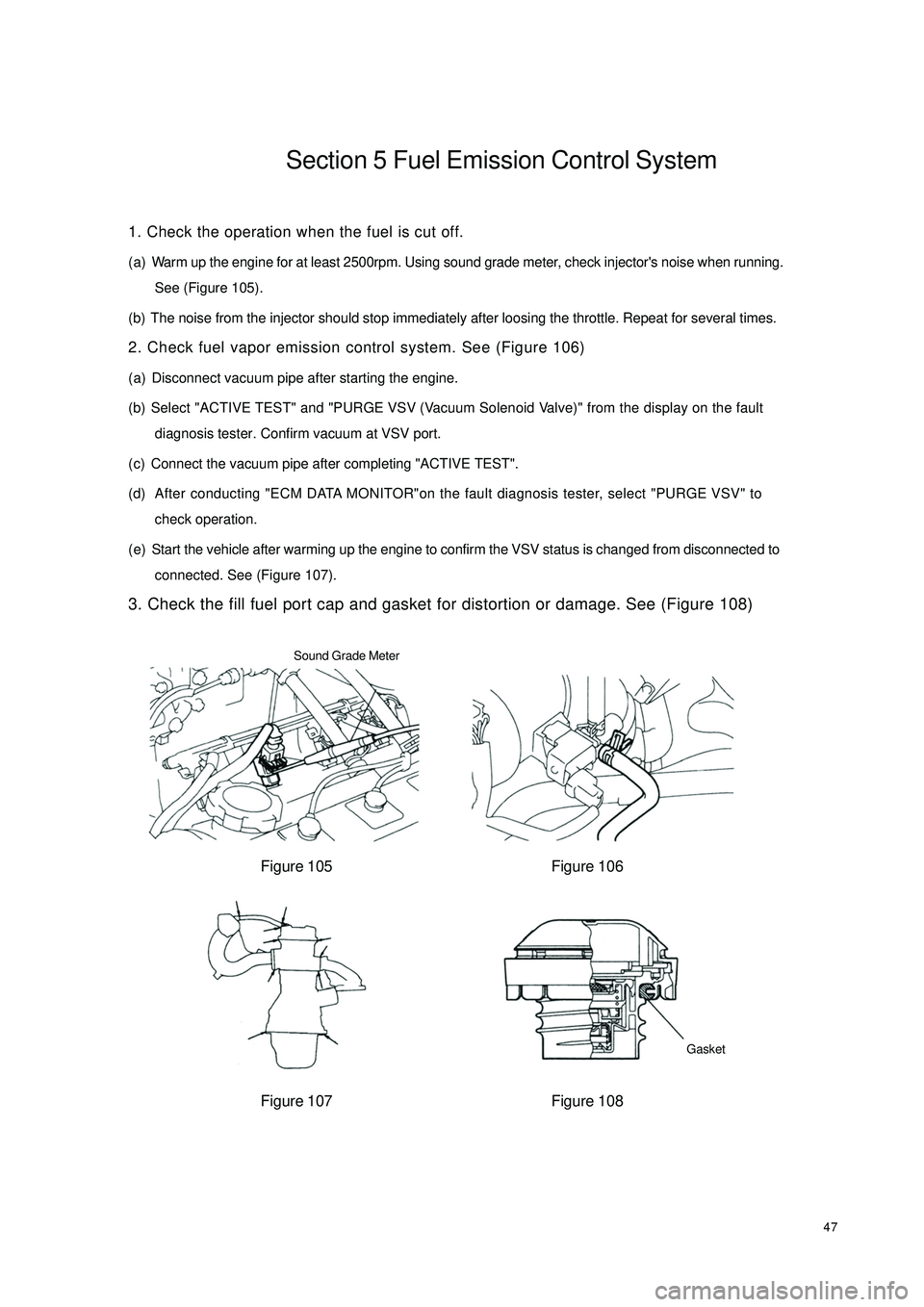
47Section 5 Fuel Emission Control System1. Check the operation when the fuel is cut off.
(a) Warm up the engine for at least 2500rpm. Using sound grade meter, check injector's noise when running.
See (Figure 105).
(b) The noise from the injector should stop immediately after loosing the throttle. Repeat for several times.
2. Check fuel vapor emission control system. See (Figure 106)
(a) Disconnect vacuum pipe after starting the engine.
(b) Select "ACTIVE TEST" and "PURGE VSV (Vacuum Solenoid Valve)" from the display on the fault
diagnosis tester. Confirm vacuum at VSV port.
(c) Connect the vacuum pipe after completing "ACTIVE TEST".
(d) After conducting "ECM DATA MONITOR"on the fault diagnosis tester, select "PURGE VSV" to
check operation.
(e) Start the vehicle after warming up the engine to confirm the VSV status is changed from disconnected to
connected. See (Figure 107).
3. Check the fill fuel port cap and gasket for distortion or damage. See (Figure 108)
Figure 105 Figure 106
Figure 107 Figure 108Sound Grade Meter
Gasket
Page 59 of 392
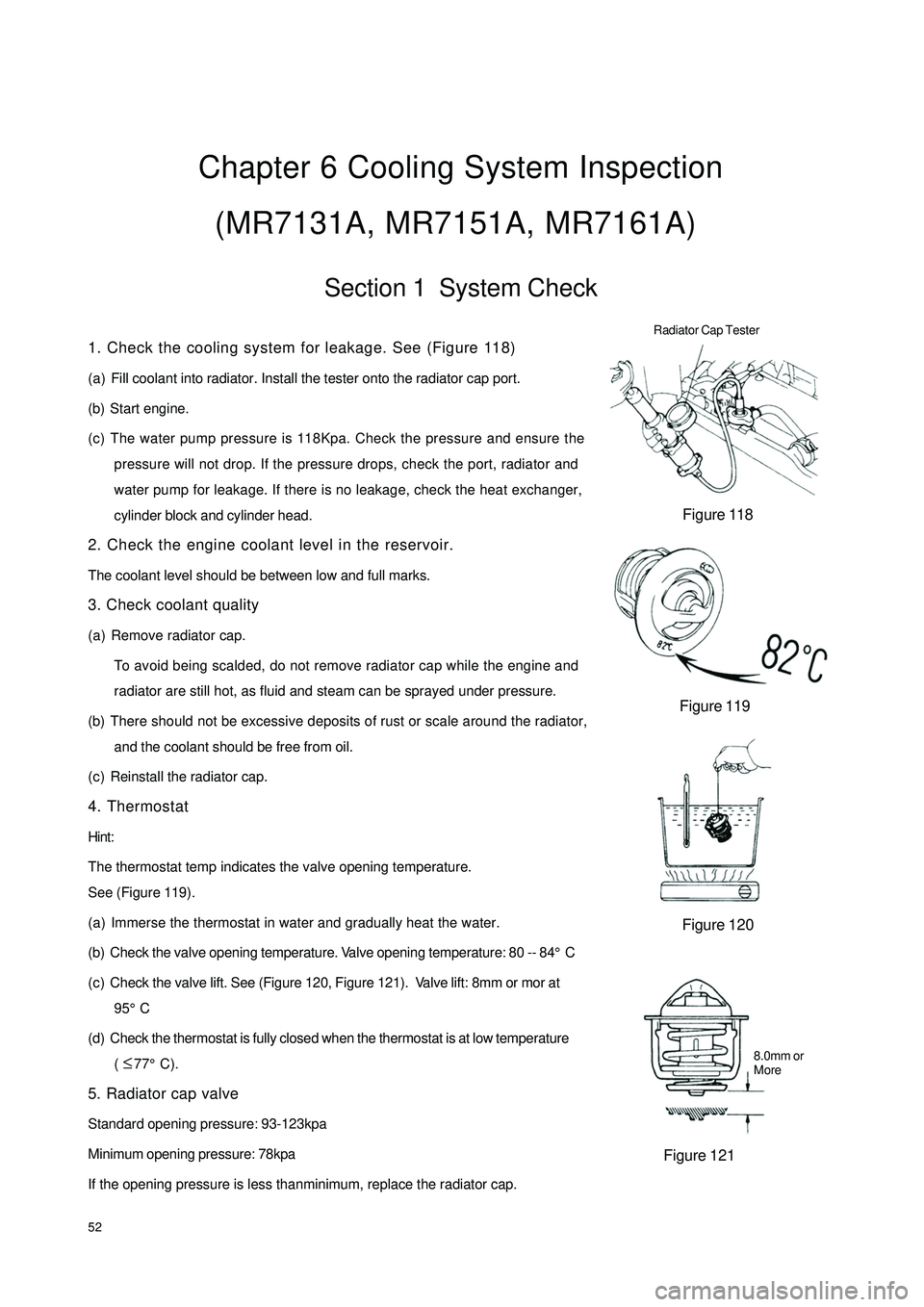
52Chapter 6 Cooling System Inspection
(MR7131A, MR7151A, MR7161A)Section 1 System Check1. Check the cooling system for leakage. See (Figure 118)
(a) Fill coolant into radiator. Install the tester onto the radiator cap port.
(b) Start engine.
(c) The water pump pressure is 118Kpa. Check the pressure and ensure the
pressure will not drop. If the pressure drops, check the port, radiator and
water pump for leakage. If there is no leakage, check the heat exchanger,
cylinder block and cylinder head.
2. Check the engine coolant level in the reservoir.
The coolant level should be between low and full marks.
3. Check coolant quality
(a) Remove radiator cap.
To avoid being scalded, do not remove radiator cap while the engine and
radiator are still hot, as fluid and steam can be sprayed under pressure.
(b) There should not be excessive deposits of rust or scale around the radiator,
and the coolant should be free from oil.
(c) Reinstall the radiator cap.
4. Thermostat
Hint:
The thermostat temp indicates the valve opening temperature.
See (Figure 119).
(a) Immerse the thermostat in water and gradually heat the water.
(b) Check the valve opening temperature. Valve opening temperature: 80 -- 84°C
(c) Check the valve lift. See (Figure 120, Figure 121). Valve lift: 8mm or mor at
95°C
(d) Check the thermostat is fully closed when the thermostat is at low temperature
( 77°C).
5. Radiator cap valve
Standard opening pressure: 93-123kpa
Minimum opening pressure: 78kpa
If the opening pressure is less thanminimum, replace the radiator cap.Figure 118
Figure 119
Figure 120
Figure 121 Radiator Cap Tester8.0mm or
More ≤
Page 60 of 392

536. Fan
(1) Check the cooling fan operation with low temperature (Lower than
83°C)
(a) Turn the ignition switch to “ON” position.
(b) Check that the cooling fan stops.
(c) Pull out the water temperature sensor connector. See (Figure
122)
(d) Connect the water temperature sensor to car body with the
wire and ground the wire.
(e) Check the cooling fan operation.
(f) Insert water temperature sensor connector.> 93°C
See (Figure 123)
(a) Start engine and make the coolant temp. higher than 93°C.
(b) Check that the cooling fan turns.
Replace it with water temperature switch if it doesn't run)
(3) Check the cooling fan. See (Figure 124)
(a) Disconnect the cooling fan connector.
(b) Connect the battery and ammeter to the connector.
(c) Check that the cooling fan rotates smoothly and check
the reading on the ammeter.
Standard amperage: 5.7 - 7.7A
(d) Reconnect the cooling fan connector.Disconnest
Figure 123
Figure 124 Figure 122
(2) Check the cooling fan operation with high temperature (over 93°C)Battery Amperometer
Page 64 of 392

57Section 1 Clutch ReplacementHoist the engine from the compartment. See "Provison 20, Section 2, Chapter 2".
1. Remove manual transaxle assembly
2. Remove the clutch release fork. See (Figure 132)
3. Detach clutch release fork boot.
4. Detach clutch release bearing
5. Detach clutch release bearing fixed clamp
6. Remove clutch fork pivot pin
7. Align the clutch cover to the mark on the flywheel. Detach clutch cover. See (Figure 133)
8. Remove clutch plate
9. Check and remove clutch plate assembly. See (Figure 134)
10. Check clutch cover. See (Figure 135)
Depth wear: A: 0.6mm
Width wear: B: 5mm
Figure 132 Figure 133
Figure 134 Figure 135
Page 72 of 392
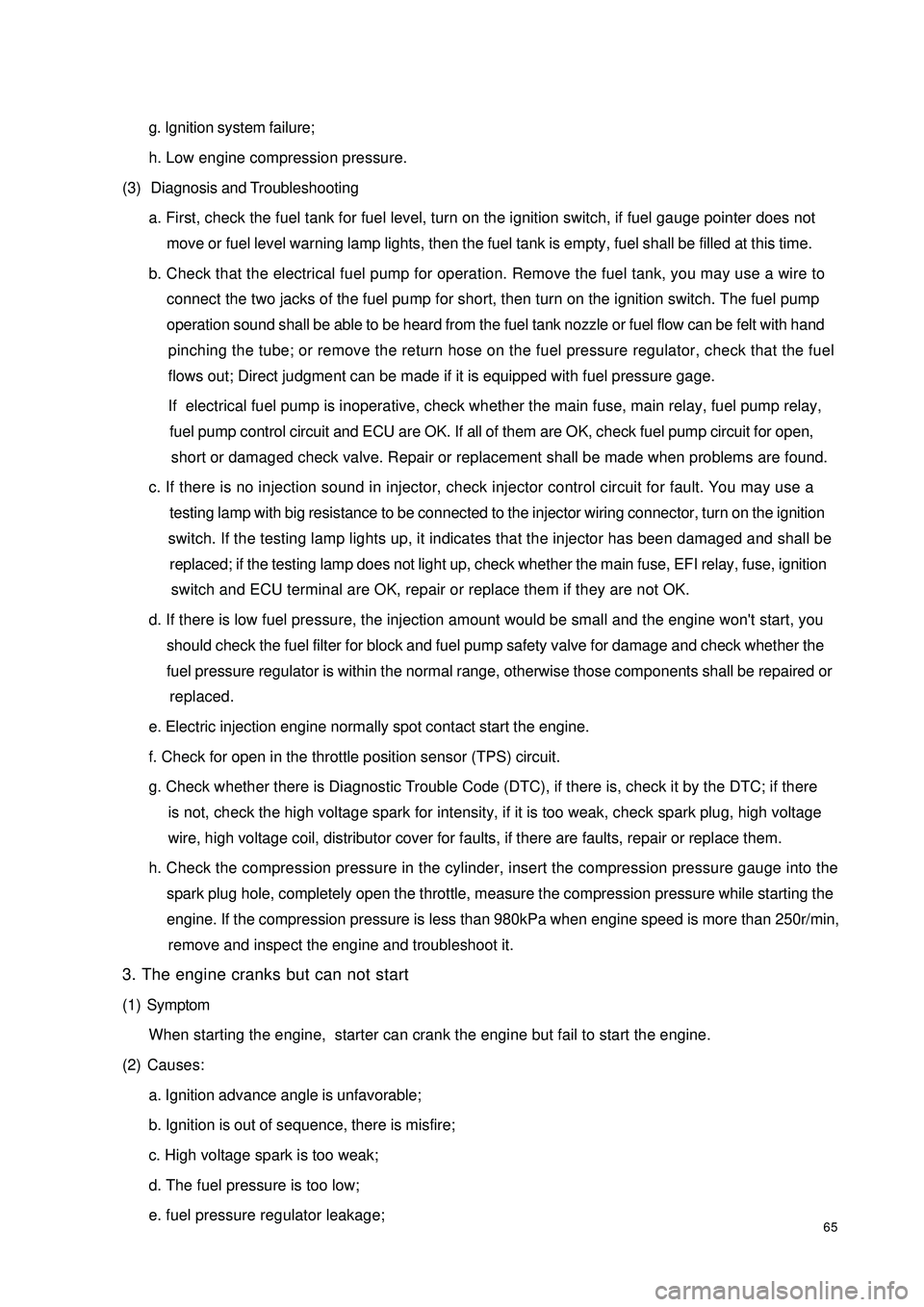
65g. Ignition system failure;
h. Low engine compression pressure.
(3) Diagnosis and Troubleshooting
a. First, check the fuel tank for fuel level, turn on the ignition switch, if fuel gauge pointer does not
move or fuel level warning lamp lights, then the fuel tank is empty, fuel shall be filled at this time.
b. Check that the electrical fuel pump for operation. Remove the fuel tank, you may use a wire to
connect the two jacks of the fuel pump for short, then turn on the ignition switch. The fuel pump
operation sound shall be able to be heard from the fuel tank nozzle or fuel flow can be felt with hand
pinching the tube; or remove the return hose on the fuel pressure regulator, check that the fuel
flows out; Direct judgment can be made if it is equipped with fuel pressure gage.
If electrical fuel pump is inoperative, check whether the main fuse, main relay, fuel pump relay,
fuel pump control circuit and ECU are OK. If all of them are OK, check fuel pump circuit for open,
short or damaged check valve. Repair or replacement shall be made when problems are found.
c. If there is no injection sound in injector, check injector control circuit for fault. You may use a
testing lamp with big resistance to be connected to the injector wiring connector, turn on the ignition
switch. If the testing lamp lights up, it indicates that the injector has been damaged and shall be
replaced; if the testing lamp does not light up, check whether the main fuse, EFI relay, fuse, ignition
switch and ECU terminal are OK, repair or replace them if they are not OK.
d. If there is low fuel pressure, the injection amount would be small and the engine won't start, you
should check the fuel filter for block and fuel pump safety valve for damage and check whether the
fuel pressure regulator is within the normal range, otherwise those components shall be repaired or
replaced.
e. Electric injection engine normally spot contact start the engine.
f. Check for open in the throttle position sensor (TPS) circuit.
g. Check whether there is Diagnostic Trouble Code (DTC), if there is, check it by the DTC; if there
is not, check the high voltage spark for intensity, if it is too weak, check spark plug, high voltage
wire, high voltage coil, distributor cover for faults, if there are faults, repair or replace them.
h. Check the compression pressure in the cylinder, insert the compression pressure gauge into the
spark plug hole, completely open the throttle, measure the compression pressure while starting the
engine. If the compression pressure is less than 980kPa when engine speed is more than 250r/min,
remove and inspect the engine and troubleshoot it.
3. The engine cranks but can not start
(1) Symptom
When starting the engine, starter can crank the engine but fail to start the engine.
(2) Causes:
a. Ignition advance angle is unfavorable;
b. Ignition is out of sequence, there is misfire;
c. High voltage spark is too weak;
d. The fuel pressure is too low;
e. fuel pressure regulator leakage;
Page 73 of 392

66f. The idle control valve is faulty;
g. The water temperature sensor is damaged;
h. The vacuum pressure sensor is damaged;
i. The air filter is blocked;
j. The injector leaks;
k. The compression pressure in the cylinder is too low;
l. The intake temperature sensor is damaged.
(3) Diagnosis and Troubleshooting
a. Check high pressure spark, check whether the high pressure spark on the ignition coil high pressure
bus and extension are OK, if the bus spark is week, replace the ignition coil, if the bus spark is OK
while the extension spark is too week, replace the ignition coil also; In addition, excessive spark
plug clearance will influence the starting feature, the clearance of the spark plug shall be adjusted
to normal value (0.8±0.1mm);
b. If there is low fuel pressure, check whether the battery voltage is OK, otherwise it shall be
troubleshot or replaced; check fuel pump check valve for leakage, check fuel filter and fuel pipe for
block, if there are leakage or block, replace or troubleshoot them;
c. If there is leakage for fuel pressure regulator, intake manifold is likely to be mixed with gasoline and
it is hard to start, troubleshoot or replace them;
d. Idle control valve can not be opened to maximum position due to mechanical wear, aging or control
circuit failure, the idle control valve shall be replaced and the control circuit failure shall be troubleshot;
e. If the water temperature sensor data is not accurate, it may cause small injection, check the water
temperature sensor based on the standard data and calibrate the data;
f. There is big time lag for intake pressure temperature sensor that makes it somewhat insensitive at
low speed and result in inaccurate injection, adjustment or replacement shall be made;
g. If the air cleaner filter is too dirty, the air flow resistance is excessively big, resulting in hard start,
as a result of it, the filter shall be replaced.
In a word, there are many factors causing the starting failure of the engine, analysis shall be made based on
the severe conditions of the faults. Generally speaking, check the ignition system first, then check intake
system, fuel system, control system, at last check the cylinder pressure, check the DTC before checking the
trouble. The diagnosis and troubleshooting procedures for starting failure of the engine are shown in (Figure
148).
Page 74 of 392
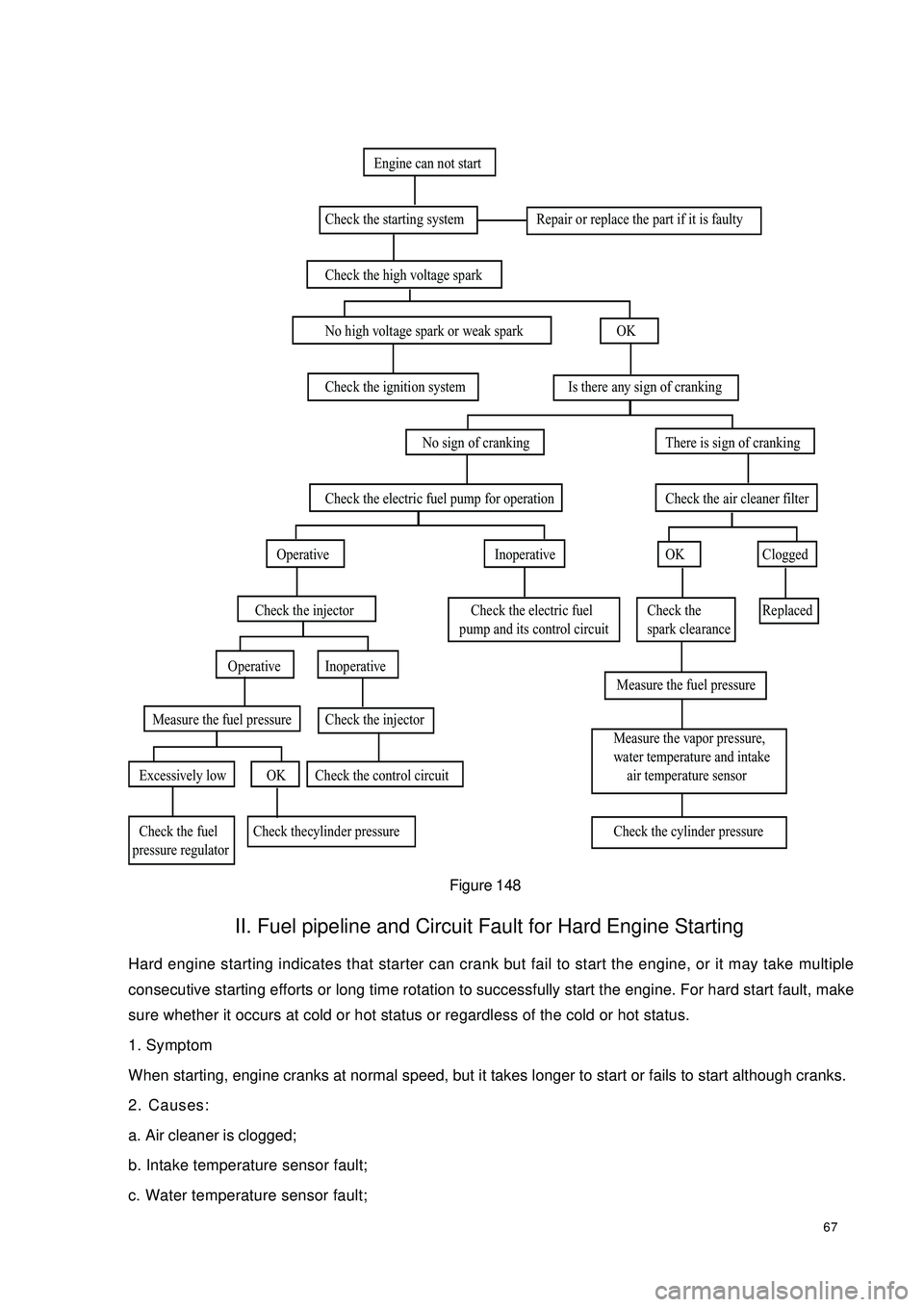
67Figure 148II. Fuel pipeline and Circuit Fault for Hard Engine StartingHard engine starting indicates that starter can crank but fail to start the engine, or it may take multiple
consecutive starting efforts or long time rotation to successfully start the engine. For hard start fault, make
sure whether it occurs at cold or hot status or regardless of the cold or hot status.
1. Symptom
When starting, engine cranks at normal speed, but it takes longer to start or fails to start although cranks.
2. Causes:
a. Air cleaner is clogged;
b. Intake temperature sensor fault;
c. Water temperature sensor fault; Engine can not start
Check the starting system Repair or replace the part if it is faulty
Check the high voltage spark
No high voltage spark or weak spark OK
Check the ignition system Is there any sign of cranking
No sign of cranking There is sign of cranking
Check the electric fuel pump for operation Check the air cleaner filter
Operative Inoperative OK Clogged
Check the injector Check the electric fuel Check the Replaced
pump and its control circuit spark clearance
Operative Inoperative
Measure the fuel pressure
Measure the fuel pressure Check the injector
Measure the vapor pressure,
water temperature and intake
Excessively low OK Check the control circuit air temperature sensor
Check the fuel Check thecylinder pressure Check the cylinder pressure
pressure regulator
Page 75 of 392

68d. Fuel pressure system abnormal;
e. Idle control valve fault;
f. Vacuum pressure sensor fault;
g. Ignition system fault;
h. The compression pressure in the cylinder is a little lower;
i. Injector leakage.
3. Diagnosis and Troubleshooting
a. Perform self-diagnosis first, check whether there is any DTC, if there is, find the reason and cause by the
DTC;
b.If it is hard for cold start but easy for hot start, check water temperature sensor and intake temperature
sensor for fault;
c. If the engine can not be started quickly in hot condition, the relief of the fuel pressure will be fast, then
repair and replacement shall be made;
d. If the spark is too weak, check high pressure coil, spark plug clearance and spark plug for carbon deposit,
repair or replace them one by one after isolating the problem;
e. Intake and exhaust valve is not completely closed, piston ring failure is likely to cause low compression
pressure in the cylinder, you should carefully repair intake & exhaust valve and seat, or replace them;
failed piston ring shall be replaced.
4. Diagnosis and Troubleshooting for hard starting and trouble shooting procedure. (Figure 149)III. Fuel Pipeline and Circuit Faults for Poor Engine OperationPoor engine operation includes: insufficient power, poor acceleration, poor deceleration, big fuel consumption,
rough idle and Engine overheat.
1. Insufficient Power
(1) Symptom:
Engine operation is normal without load but slow at load, insufficient power when uphill and not improved
even if the accelerator pedal is completely depressed, speed can not be increased and unable to reach the
maximum vehicle speed.
(2) Causes:
a. Air cleaner is clogged;
b. Poor intake system seal;
c. Intake pressure temperature sensor fault;
d. Low fuel pressure;
e. Broken pressure adjustor;
f. Clogged injector or poor atomization;
g. Throttle position sensor fault;
h. High pressure spark is too weak;
i. Improper valve clearance;
Page 76 of 392

69j. Poor intake and exhaust valve seal, failed piston ring, low compression pressure;
h. Too many carbon deposit in spark plug and combustion chamber;
k. Water temperature switch and thermostat fault;
l. Aging of Oxygon sensor;
m. Incorrect ignition timing;
n. Check valve fault.
Figure 149Engine is difficult to start
Check whether the air cleaner is clogged Clogged
Troubleshooting
OK
Check the idle control valve NG
Repair or replace
OK
Check the fuel pressure Excessivly low
Service the electric fuel pump,
fuel filter and fuel pressure regulator
OK
Check the vacuum pressure sensor NG
Replace
OK
Check the water temperature sensor and intake air temperature sensor NG
Replace
OK
Check the start switch signal No
Service the start signal wire
OK
Check the ignition timing Misaligned
Adjust
OK
Check the cylinder pressure NG
Disassemble the engine
OK
Replace the ECU to retry
Page 77 of 392
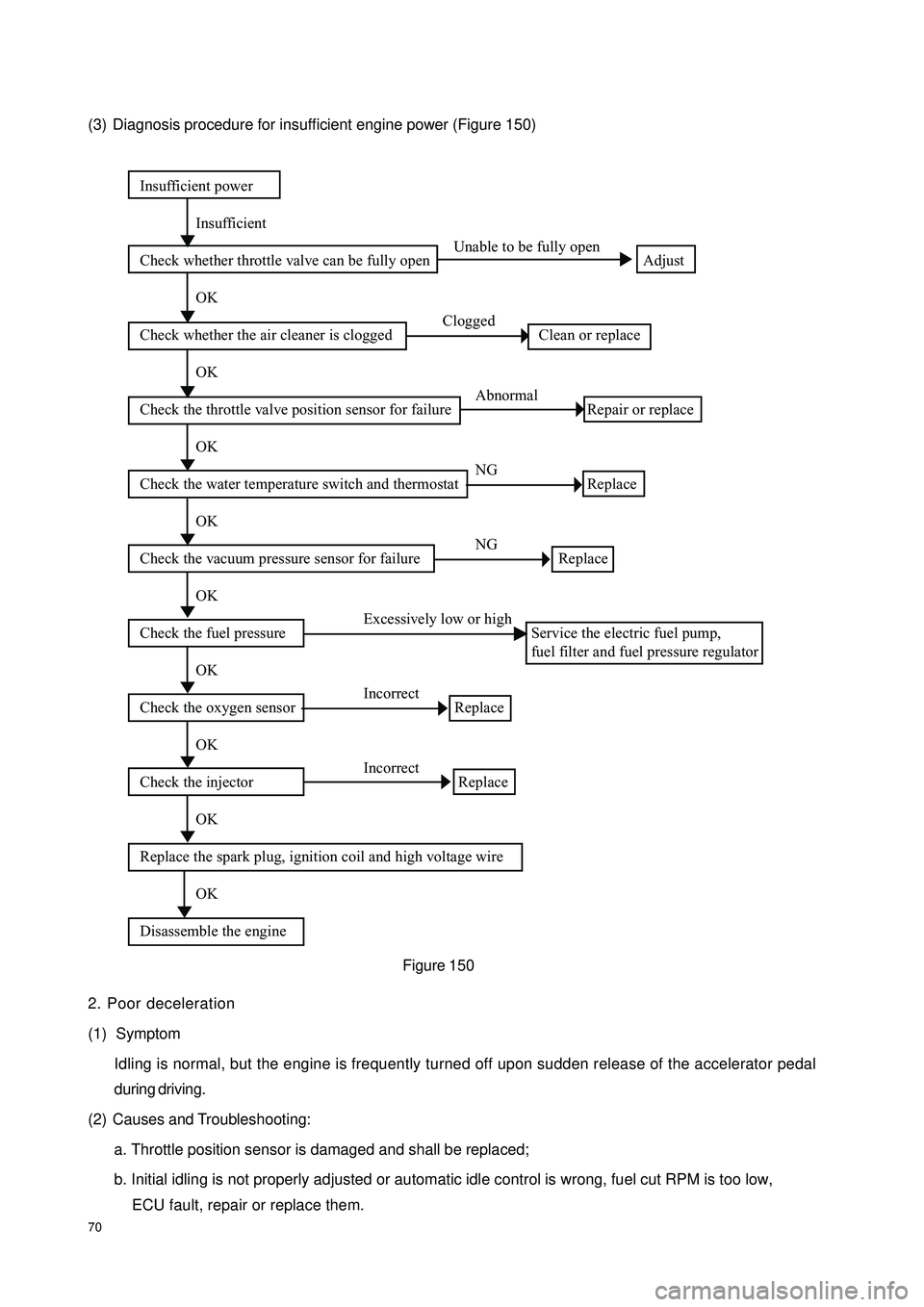
70(3) Diagnosis procedure for insufficient engine power (Figure 150)
2. Poor deceleration
(1) Symptom
Idling is normal, but the engine is frequently turned off upon sudden release of the accelerator pedal
during driving.
(2) Causes and Troubleshooting:
a. Throttle position sensor is damaged and shall be replaced;
b. Initial idling is not properly adjusted or automatic idle control is wrong, fuel cut RPM is too low,
ECU fault, repair or replace them.Insufficient power
Insufficient
Check whether throttle valve can be fully open Unable to be fully open
Adjust
OK
Check whether the air cleaner is clogged Clogged
Clean or replace
OK
Check the throttle valve position sensor for failure Abnormal
Repair or replace
OK
Check the water temperature switch and thermostat NG
Replace
OK
Check the vacuum pressure sensor for failure NG
Replace
OK
Check the fuel pressure Excessively low or high
Service the electric fuel pump,
fuel filter and fuel pressure regulator
OK
Check the oxygen sensor Incorrect
Replace
OK
Check the injector Incorrect
Replace
OK
Replace the spark plug, ignition coil and high voltage wire
OK
Disassemble the engineFigure 150